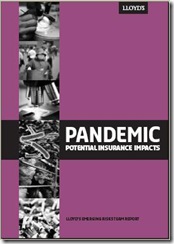# 2935
Last October Lloyds’ issued a pandemic impact report for the Insurance industry entitled PANDEMIC:Potential Insurance Impacts.
Today the Chartered Insurance Institute (CII) released a new report by Trevor Maynard, Emerging Risks Manager at Lloyd’s, entitled Pandemics: Be Prepared.
First the article from the InsuranceTimes, then a link to the new report, and a quick look at last October’s report.
25 March, 2009
Thinkpiece braces insurers for economic losses
In the latest Chartered Insurance Institute (CII) Thinkpiece "Pandemics - be prepared" Trevor Maynard, emerging risks manager at Lloyd's, highlights the risks posed by pandemics and what the next one could mean for the insurance industry.
He says that a major pandemic will have significant economic consequences and cites the outbreak of SARS in 2002 that caused economic losses of up to $150bn. The last global pandemic was in 1918 and the report notes historically such events occur every 30 to 50 years; it also cautions against use of the 1918 model as the world has changed much since then - better technology and greater population movement - and warns that a re-run of 1918 could lead to a recession with estimated impacts ranging from 1% to 10% of global GDP.
Insurers will be on the front line and must ensure policies are designed to respond to such situations, the report states, emphasising they should consider new technologies and changing methods of working to cope with stresses that an outbreak would put on business.
(PDF File- Click to Download)
While this report is only 4 pages in length, it is well worth reading in its entirety. I’ve reproduced the summary below.
Summary
- The risk of pandemics is ever present. The last global pandemic was the Spanish Flu outbreak in 1918, and historically such pandemics typically occur around every 30-50 years. Indeed the Commissioner of the City of London Police said, last year, that a pandemic at some point is “inevitable”. Many argue that we are better off today for facing the next outbreak as a result of a number of factors including better drugs. However there is concern that the next pandemic could be worse than those in the past.
- Contingency and business continuity planning is vital. When planning contingencies it would be wise to consider alternative scenarios to the 1918 Spanish Flu outbreak; to ensure response plans do not “over-optimise” to one scenario.
- A major pandemic is expected to have significant economic consequences. The outbreak of SARS in 2002 caused economic losses of up to USD150bn. Research suggests that states in the US will lose up to 8% of their GDP in a major pandemic.
- Insurers must consider the impact of pandemic on various policy classes and when doing so they ask themselves “was the policy designed to respond in this situation”? We can expect life and health insurance policies to be materially impacted and this will affect the finances of reinsurers that offer to protect mortality losses. Insurers need also to take in to account the impact upon their own staff.
Last October I examined, in depth, the Lloyd’s Report on the Pandemic Threat (see The Lloyds Report: A Closer Look). If you haven’t read that blog, and the report that inspired it, I would recommend that you do so.
Pandemic concerns, you see, are not just held by bloggers and public health officials. The Insurance Industry views a future pandemic as a very real, and potentially serious, danger.

